Princess Mononoke: A Film On Human & Animal Nature
"Life is suffering. It is hard. The world is cursed but still you find reasons to keep living." - Gosa

After re-watching this film, I thought it was a great idea to analyze the 1997 animated film Princess Mononoke. This is a film that grips pain, sorrow, and sacrifice. Its beautiful images, sceneries, and characters complete this film, making it one of the best from the works of Miyazaki.
WARNING: THIS WILL CONTAIN SPOILERS.
I will be breaking down the characters, themes as well as character growth with some of the characters.
A Cursed Prince
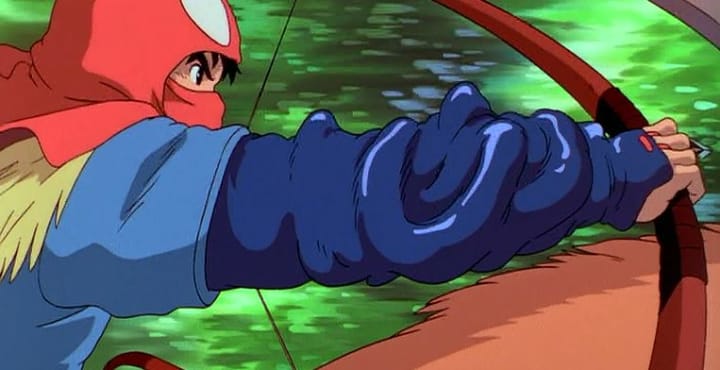
The story begins with you meeting Ashitaka, a prince of a scarce tribe called the Emishi Tribe. He's been summoned to check on in the forest. The creature soon reveals himself as a demon in a wounded boar's body. In a rage, the boar heads towards the village where the Emishi tribe is located. Ashitake steps in to stop the creature and with his boar and arrow, hits the animal in the eyes. The boar then dies saying:
Disgusting Creatures. Soon, you will feel my hate and suffered as I have suffered.
The boar leaves a curse on Ashitaka's arm, which will then kill him. Because of this, Ashitaka leaves his tribe and goes on a journey to see the source of the boar's anger.
The part where he leaves is heartbreaking. He's the youngest of the men in his tribe, and he's banished to not come back. If you look closely in the scene, a man in the back is holding back tears, as Ashitaka cuts his hair.
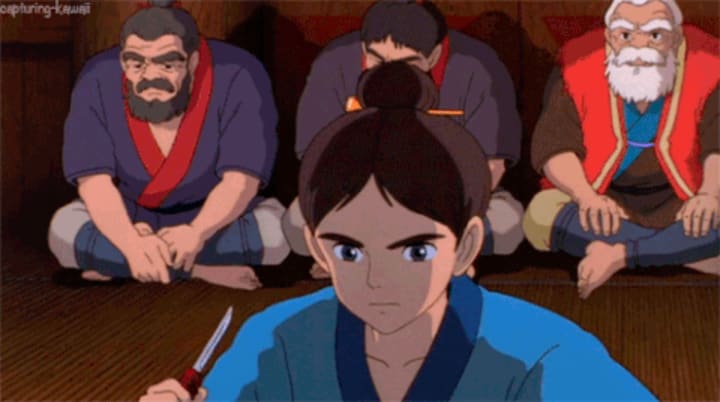
In an article from WordPress, Eric Renders give a brief overview of the symbolism behind Ashitaka cutting his topknot. Cutting off the topknot is actually a ritual tied to the ways of Samurai.
"Samurai, who during the Edo period represented the highest level of society, were typically denoted by having topknots. When a samurai decided to cut his hair, he was ultimately deciding to give up his social standing. After the removal of his topknot, a samurai would either decide to enter into priesthood or resume life as a peasant. Therefore, when Ashitaka cuts his hair, he is abandoning his social status as a clan leader in order to embark on his quest to find a cure for his curse." says Renders.
San, the Wolf Girl

San is a 16-year-old girl who was raised by the wolves of the forest. Her mother is one of the gods of the forest. She, as well as her pack, has one goal: protect the creatures of the forest. We first see her charging towards the villagers of Iron Town. When her mother is wounded from a gunshot, she uses her mouth to clean her wound. This is when she and Ashitaka meet. The first impression isn't the nicest, as she says bluntly to Ashitaka "Go away." She sees him as a threat.
The reason why San isn't the nicest towards humans in this film is that the humans she sees are taking supplies from the forest, and killing animals from the forest. Iron Town takes coal, and iron from the forest so they can trade for food and supply for the people of the town.
Another thing I see is that she doesn't think she's human. She believes she's like the wolves. There's a particular part of the movie where she confronts Ashitaka. Ashitaka tells her she's human and she yells back that she's a wolf. She's one of my favorite characters, and her character development, letting Ashitaka into her personal space and emotions, is someone she probably would have never done in the beginning.
Toki & The Women Of Iron Town

The women of Iron Town is what I absolutely love. Not only do they handle weapons, but they are the catalyst of why the town is so successful. They work pretty much every day, pumping the machines to help make iron.
According to the townsmen, the women were originally from brothels. Lady Eboshi bought their contracts, allowing them to be free, and live in the town, which I actually love. The women aren't easy to push over either and almost carry a more male role.
Toki is one of the main characters. She embodies more of an alpha female role, she's hard-working, strong, and has a leadership mindset. If Lady Eboshi wasn't in charge, it would make sense if Toki was in that position.
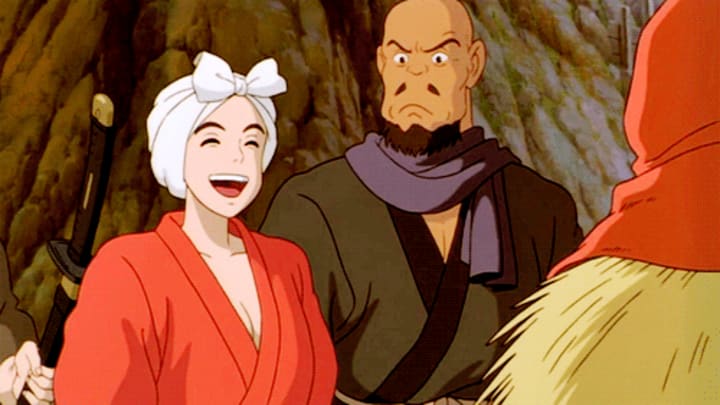
Toki is also married to Kohroku, who Ashitaka saves. I laugh every time the duo is on screen together. She loves him but hates when he slacks off. I get why she's upset though. It's either he's scared or complaining about something, but I love the humor they present in the film, to give the audience relief from the seriousness of the film.
Lady Eboshi and her intentions
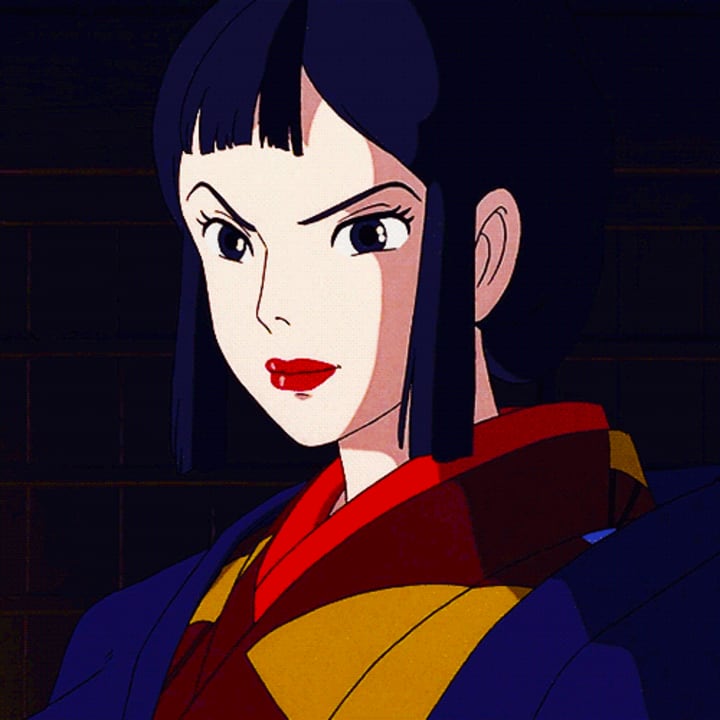
Lady Eboshi is another strong female role in this movie. She's the leader of Iron Town. Though what she was doing to the forest and the animals was horrible and even inhumane, she had good intentions.
Eboshi is seen as the antagonist of the movie. She makes weapons to take over parts of the forest, so she can make more money for her town. Her actions are very selfish and greedy. But, she's the main reason behind women's freedom and independence. She treats the people like her own family. She's only trying to make good decisions for them.
She even takes it upon herself to allow the women to own weapons and requests that guns are made for the women to defend themselves. There's a scene where she's discussing with Ashitaka why she wants to kill the spirit of the forest. She includes San in her reasoning, saying that her soul was stolen. She technically wasn't wrong, but she didn't really know the reason behind San's upbringing in the wolf pack.
Eboshi is more relaxed, poised, and has a laid-back attitude. She's also very observant and doesn't get persuaded easily. That is why she is a great example of what a leader is. Towards the end, she fully accepts that she was wrong and wants to thank Ashitaka for saving her.
The fight between humans and people
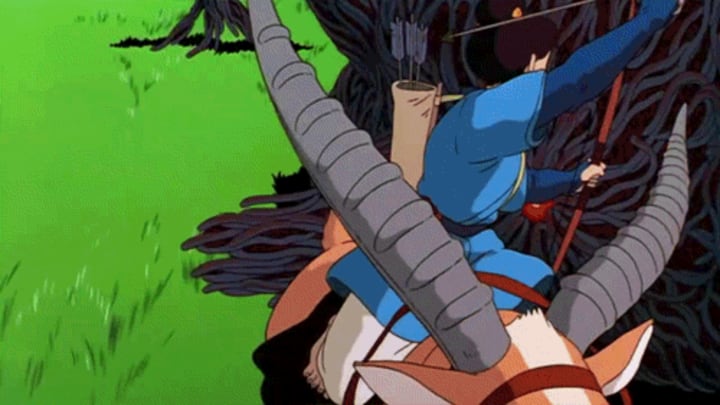
This story is all about the war between man and beast. The animals want to be treated respectfully and have their forest, and the people want to have their supplies. It's a movie that perfectly relates to animal cruelty in our modern-day world but instead set in the Edo era.
The rage that's displayed in the movie is a very interesting concept. Miyazaki displays the bull's anger at the beginning of the film as it consuming him, and doesn't even show the bull's body until he's dying.
Yakul, who is Ashitaka's elk, displays love and soul to soul connection with him. They think, and work together as if they are one embodiment. You can also see that with San and wolves. This proves that the animals have emotions, and can feel pain, which most people believe animals don't understand emotions the way humans do. Lady Eboshi treats animals in an inhumane way, seeing them as only threats and beasts. She doesn't have empathy towards the creatures vs. how she is towards the people of Iron Town. It's truly a sad story to watch, people die because of greed and hate.
The war between people is also influenced in this film, and greed as they try to bounty the forest spirit for immortality. They harm animals and spirits in the process to get to the source. Them doing this, causes the forest spirit to react in hate and anger.
The Spirits Of the Forest
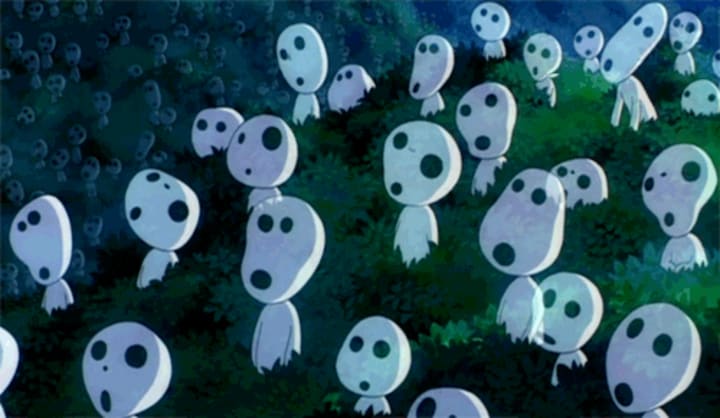
Kodama (木魅 ): The Kodama spirits are small spirits that move its head and click to communicate. They are a very important part of the forest, as they signify that the forest is healthy.
Forest Spirit (シシガミ): The forest spirit, also known as the Shishigami, is the main source of the forest in the film. He is considered a God, and he brings things to life, and gracefully brings things to rest. The image of the spirit is a bit overwhelming, he has a deer body and a red human face. The fact that he didn't react, and had only a smile on his face always made my skin crawl. I genuinly liked the spirit in the nighttime, he changed into a blue giant, and it's a sin to look at the spirit change.
Moro (茂呂): Moro is the wolf spirit in the film, that is also San's mother. San is a princess, because of her mother's status in the forest. She protects the forest and keeps it safe. She is calm and observant and is understanding of San's emotions.
Nago (名古): Nago is one of the leaders of the Boar clan. We see Nago in the beginning as a demon god, blinded by hate. Ashitaka kills him shortly after he appears in the film.
Okkoto (乙事主 ): Okkoto is another leader of the Boar clan. Blind with white hair, shows how old he is. Okkoto, though wise, is more focused on fighting for justice, and later becomes a demon god.
The Ape Tribe (猩々): The ape tribe is rarely shown in the film but they are the engineers of the forest. They create and grow the trees. They threaten the wolf tribe in the film and want to eat Ashitaka to kill the people of Iron Town.
Concluding this analysis, this movie is an adventure. You laugh, and cry with the emotions included in this film, and is worth watching!
Please check out the analysis from Steve Reviews by clicking here.
----------------------------------------------------------------------------------------
Thank you for reading my story! Please like, share, and tip for the support!
Follow me @lafrankiesha
About the Creator
nostalgia.radio🪲
---- Article & Fictional Writer On Vocal. Media ---
☀️ Host of the "A Collaboration of my Emotions” podcast ☀️






Comments
nostalgia.radio🪲 is not accepting comments at the moment
Want to show your support? Send them a one-off tip.